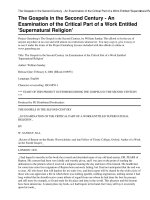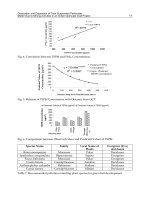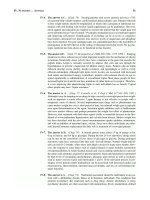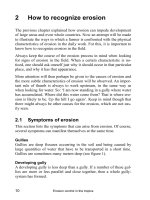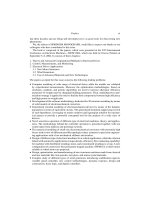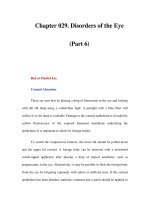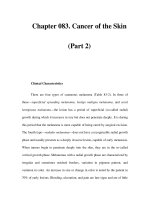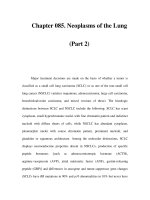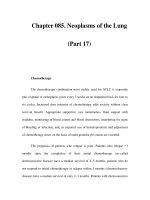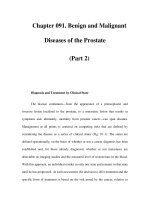Examination of the Newborn - part 2 docx
Bạn đang xem bản rút gọn của tài liệu. Xem và tải ngay bản đầy đủ của tài liệu tại đây (265.89 KB, 23 trang )
relationship. Childlessness has a negative image and often leads
women to become stigmatised irrespective of whether or not it is a
chosen status. Some women will therefore go to their physical,
psychological and financial limits in order to become a mother.
The success rate for the many techniques that are used to treat
infertile couples vary from centre to centre (Human Fertilisation
and Embryology Authority 1999). Success is also influenced by
factors such as the cause of infertility, age (particularly the age of
the oocyte), sperm and embryo quality, previous obstetric history
and pre-existing morbidity.
There is also inequality in the provision of treatment for
infertility; many centres offer free treatment on the National
Health Service; however, the access criteria vary widely along with
the length of waiting lists, described in detail in the National
Survey (National Infertility Awareness Campaign 1998). The result
is that most couples pay for treatment, which may amount to
thousands of pounds.
It may not be evident from examination of the woman’s case
notes whether or not she has undergone investigations or
treatment for infertility, especially if donated gametes have been
used and the couple wish to keep this a secret. This is entirely
their right under the Human Fertilisation and Embryology Act
1990. The practitioner examining the baby must not assume,
therefore, that the baby’s parents are its biological ones (this may
also apply if the baby has been delivered from a surrogate
mother). If, however, the mother does disclose having received
fertility treatment and this is recorded in her case notes, some of
the abbreviations shown in Table 1.1 may be documented.
After the birth, it is a possibility that the mother may feel quite
detached or even indifferent to her new baby, despite her long
wait. This is difficult for both her and her partner to cope with,
especially when everyone else is so pleased and relieved at the
successful outcome. Women will benefit from the gentle
reassurance that this is a common reaction following childbirth,
and that it sometimes takes time for mother and baby to form a
strong bond. The literature does not support the hypothesis that
parents of IVF children are maladaptive, although more empirical
research in this area is required (McMahon et al. 1993).
Consider your response to a parent who expresses concern
about the effects of infertility treatment on the newborn
baby.
IN THE BEGINNING 7
The mother whose baby was conceived through the application of
reproductive technology may have concerns about the effect of the
drugs that she was given in order to maintain her pregnancy.
Such worries are not entirely unfounded in view of the devastating
effects of such drugs as diethylstilboestrol, which was used to
prevent recurrent miscarriage and led to cases of genital cancer in
babies exposed in utero, and thalidomide, which was used to treat
nausea and vomiting in pregnancy and was held responsible for
many severe limb defects. We await with trepidation any sequelae
of assisted conception in either the mother or the fetus.
There is no evidence to suggest that babies born through IVF
show a greater percentage of abnormalities than the general
population. However, there is concern regarding children born
through ICSI as there is greater manipulation of the oocyte. There
is also the likelihood that male children may inherit their father’s
infertility problem. There are insufficient cohorts of children yet
born through ICSI to support any final conclusions.
As the professional who examines the newborn infant it is
impossible to predict or detect whether or not this baby will have
an increased risk of morbidity in future life as a result of infertility
TABLE 1.1 Methods of assisted conception
8 EXAMINATION OF THE NEWBORN
treatment. It is possible, however, to state, should the parents
inquire, that there is no current evidence to suggest that there will
be major long-term effects from such treatment. In one study 100
babies who had been conceived in vitro were compared with babies
conceived spontaneously (Fisch et al. 1997). There were no
differences in the incidence of either major or minor abnormalities
between these two groups of neonates. This was a small study and
there is a need for much larger longitudinal studies before any
concrete reassurance can be made. Increasingly, the embryos
resulting from IVF will undergo pre-implantation diagnosis (PID),
and thus their chromosomal status will be confirmed before being
returned to the mother. However, it would be inappropriate to
state categorically that this baby will not develop problems in the
future (see Chapter 7).
Questions that new parents may ask
Having successfully given birth, the new mother will face many
decisions and challenges ahead. She may turn to the practitioner
for advice and guidance during this emotional time, and although
you will not have all the answers it will be useful to consider some
of the issues that could arise so that you can deal with them
sensitively. The first thing you must ask yourself is: Am I the most
appropriate person to answer this question?
This is particularly relevant if you are not the practitioner with
continuing responsibility for that woman. In such circumstances,
some questions, although you might have the knowledge to
provide an answer, should be directed to the midwife who is
assigned to the care of that woman. For issues such as breast
feeding, for example, it may be the case that a variety of options
have been tried or are planned. Without precise knowledge of
previous discussions the practitioner may cause confusion. It may,
however, be appropriate to give general advice about future care,
but again her midwife should be informed of any concerns that
may have been highlighted.
As you gain experience in the examination of babies, a pattern
of frequent questions may emerge for your particular client group.
Questions such as entitlement to benefits or the presence of local
postnatal groups will need to be fielded with reference to the
maternity services in your area. These are simple questions to
answer, but some questions require more thought. There are a
multitude of potential questions, but in order to help you consider
the issues the new mother may face and how you as a practitioner
IN THE BEGINNING 9
might handle them, we shall explore one question in detail, that of
employment.
Employment
For women who have achieved a successful career, it is can be
difficult for them to fulfil the roles of both a full-time mother and a
full-time worker. It has been suggested that it is almost impossible
to combine these roles effectively because of the underinvestment
in adequate child care provision. Many career opportunities are
forgone in order to become a mother, confirming the stance that
motherhood and paid employment are incompatible (Richardson
1993). There is often a conflict of interests: returning to work after
the birth of a child enables the woman to develop her skills,
communicate with other adults and be financially independent,
but it also requires her to become ‘superwoman’ and juggle many
responsibilities at the same time. Although many women are
fortunate and share their commitments in a balanced
relationship, many more do not and they often have to take time
off work when the child is sick or to meet other, numerous
responsibilities.
Women who, because of either financial necessity or personal
choice, decide to return to work, no matter how definite that
decision was, often suffer feelings of guilt. The new mother,
overwhelmed by a myriad of emotions in the first few days after
the birth, will be susceptible to the views and flippant statements
of the professionals she meets.
Consider how a new mother might perceive the innocent
questioning of the professional examining her baby when
asked, ‘do you work?’
The professional examining the baby may just be trying to make
conversation spurred by the fact the parent’s occupation was
noted during close review of the case notes. Whether or not
mothers should work is an extremely emotive issue. Many women
simply do not have the choice and have to work in order to pay the
bills. Others have chosen to stop working and stay at home while
the children are young and they are able to ‘happily relinquish
ambition’ (Hampshire 1984).
Many more women return to work on either a full- or part-time
basis and will need support in order to minimise the associated
guilt feeling they will inevitably experience. Even Hugh Jolly, an
authority on aspects of childcare, states:
10 EXAMINATION OF THE NEWBORN
Mothers should not feel guilty if they want to continue
working while their children are still babies; it is better to be
a happy ‘part-time’ parent than a depressed ‘full-time’ one.
(1985: p. 136)
Of course, not everyone the new mother meets will express such
enlightened views. Before the Second World War much attention
was focused on the adverse effects on the institutionalisation of
children and much of this work fuelled the theory of maternal
separation and maternal instinct which became central to the
work of Bowlby (1953). This considered opinion took the stance
that it was indeed dangerous and stressful for children to be
separated from their mothers and that mothers should not work
but should stay at home caring for and nurturing their children.
We now know that this is not the case and that as long as children
have caring and consistent mother substitutes they will not come
to any emotional harm (Hilton 1991). Despite this knowledge, it is
often the former deprivation theory that remains deep seated in
our culture and society. This means that not only do women feel
guilty if they work, but also that family members, friends and
colleagues have something to say on the matter (especially if they
themselves stopped working after the birth of their children).
As with all these situations the converse is also true. Some
women who do give up work are made to feel, by their career-
minded acquaintances, that they are missing out on
companionship, stimulation and, of course, money by staying at
home. The role of the professional at these times of complex
uncertainty and guilt is to be the neutral sounding board,
enabling women to explore their own feelings without being judged
or interrogated. At the end of the day, they will need to make a
decision that is right for them, not for us.
Consider how would you respond to a mother who asked
you, ‘when is the best time to return to work?’
This is a difficult question to answer and is of course linked to all
the emotional guilt that relates to the previous scenario. There is,
however, some useful ground that can be covered in response. For
example, if the woman is breast feeding you can outline ways in
which feeding can be maintained even after returning to full-time
employment, and you can encourage her to seek the advice of the
local feeding advisor, if there is one. In addition, there are many
sources of further information such as community midwives,
IN THE BEGINNING 11
health visitors, La Leche League and the National Childbirth Trust
(see Appendix 1).
It is useful to find out what plans she has and fill in any
relevant details, such as ‘yes, the baby might be sleeping through
the night by then’ or ‘the baby will have had all injections by
then’, etc. Other useful suggestions might be to encourage her to
take a day’s annual leave each week for a while so that she
becomes used to the new situation gradually. Health Visitors often
know of local childminders that can be recommended or what
facilities there are further afield. Whatever the woman is planning
on doing it must be right for her, but she may ask you what you
did when your children were young, if you have any. Even though
there are certain stages at which it may be less traumatic for the
mother to return to work, it will always be a source of anxiety and
grief. This can be minimised by the professional who does not seek
to impose rigid strategies but who listens to each individual and
their unique social circumstances.
Some of the issues that face new parents have been considered
along with the possible responses of the practitioner. No two
women or their babies will be the same.
Consider this next account and reflect on how even women with
very straightforward social and obstetric histories may face
dilemmas when embarking on motherhood.
A personal account
I have always wanted children. When asked as a child what
I wanted to be when I grew up, I would fervently retort, ‘a
mummy of course’. One might suppose that this was a
consequence of my upbringing, the environment in which I
grew up; however, this view point does not hold water when
one considers my sister’s reply to the same question, ‘I’ m
going to be the Prime Minister’. I hope you don’t think I am
some sort of sissy or something, wanting to be a mummy for
as long as I can remember, but it is the one thing in my life I
never doubted for a second I could do. Even when my sister
was undergoing investigations for infertility. Five years my
senior, my sister was undergoing dye tests and hormone
levels measurements when I was ready to start trying for our
first baby.
I was in a dilemma. Should I wait until she became
pregnant before I tried, because I did not want her to go
through the added trauma of seeing me pregnant when she
wanted to be? How long would if take? What if she could not
12 EXAMINATION OF THE NEWBORN
have children—I’m sure she would not have wanted me to
remain childless too. We decided to go ahead and try for our
baby and I conceived straight away. My sister was the first to
know and of course she was absolutely delighted, never once
making me feel guilty. I never knew how she felt when we
were not together.
We laugh now. Her daughter is the same age as my second
child—she successfully conceived through IVF. She laughs at
the many years of messing about with the whole range of
contraceptives available, never knowing what a waste of time
they were for her. I’m thankful I made the decision I did.
Summary
It is with appreciation of the preceding events, dilemmas and
expectations that the practitioner examines the newborn infant.
Although not all the information may be available, it is important
not to jump to conclusions for they are likely to be inaccurate.
This is difficult to avoid as everyone uses assumptions to help
them interact with people they have never met (Green et al. 1990).
However, generalisations apply to very few people, so it is more
appropriate to verify details that are pertinent to the examination
with the mother and use observational and listening skills to
complement understanding of the wider context. The range of
variables that influence the newborn’s environment is vast and
their combination covers an even greater range. They will all have
an impact on the future life and opportunities of the newborn
baby.
The next chapter will focus on normal fetal development,
enabling the practitioner to relate the impact of intrauterine life on
the examination of the newborn.
IN THE BEGINNING 13
14
Chapter 2
Fetal development: influential
factors
Introduction
Fetal development
Summary
Introduction
Most pregnancies are free from complications, and the developing
fetus grows strong and healthy in preparation for extra-uterine
life. Some babies are, however, already compromised as a result of
hazardous exposure during pregnancy. Before the practitioner
begins the examination of the neonate, she will take the essential
step of reading the mother’s case notes and thus familiarising
herself with the antenatal history. It will be in the light of this
information that the baby is examined, and the practitioner will
need to consider the implications of antenatal events for the
mother and baby so that they can be anticipated. Some women
may have spent months worrying about something that happened
during the pregnancy and may look to the practitioner examining
their baby for reassurance.
This chapter will begin with a brief account of normal fetal
development to enable the reader to place in context the relevance
of potential hazards, such as exposure to rubella during
pregnancy. It will then discuss in more detail the major known
antenatal risk factors, giving the practitioner a quick reference to
their potential effects. Such knowledge will equip the reader with
the ability to reassure and inform parents when they seek advice
during the first examination of their baby.
Fetal development
It is important that the practitioner who examines the baby is able
to apply knowledge of the stages of fetal development to the
individual antenatal history of the baby under examination.
Table 2.1 provides a guide to the development of the various
systems of the body.
The gestational development of the fetus is extremely relevant to
the examination of the newborn, especially if the woman has been
worrying about a particular event in her pregnancy, such as an
infection. If an abnormality is discovered, it is important to be
aware that parents often blame themselves, and that they will
make links with episodes from the antenatal period that might be
causal in effect. Such concerns need to be listened to carefully and
worked through systematically in order that they can be put in
perspective and usually excluded.
The sections that follow will focus on the most relevant sources
of potential fetal compromise and include smoking, alcohol, drug
abuse, infection and environmental hazards. Information relating
to fetal exposure to these influences is collected during the first
consultation between the woman and her midwife or doctor, the
‘booking history’, and recorded in her notes (see Table 5.1). Such
data may then be updated throughout the antenatal period.
Smoking
Despite the wealth of information regarding the harmful effects on
the fetus of smoking in pregnancy, approximately one in three
women smoke at the beginning of their pregnancy (Madeley et al.
1989) and between 60% and 70% of those women continue to do
so (USDHHS 1990). There may be many factors which contribute
to this fact, including addiction to nicotine, habit, lack of support
from family, friends and professionals or misconceptions
regarding the effects of inhaling tobacco smoke. Approximately 4,
000 fetuses are lost each year as a result of smoking in pregnancy
(Royal College of Physicians 1993) and many more are harmed by
the combined effects of carbon monoxide and nicotine.
Carbon monoxide Found in cigarette smoke, it binds with
haemoglobin, forming carboxyhaemoglobin.
It is able to cross the placenta and thus
reduces the oxygen-carrying capacity of both
the mother’s and the fetus’s blood.
16 EXAMINATION OF THE NEWBORN
Table 2.1 Development of fetal organs and systems
FETAL DEVELOPMENT 17
Nicotine Causes generalised vasoconstriction, which
leads to reduced blood flow to the uterus and
is therefore another mechanism whereby the
oxygen supply to the fetus is reduced.
In addition to the dangers that tobacco inhalation poses for all
smokers (cancer, respiratory disease, cardiac disease) children
exposed to cigarette smoke both before and after birth are also
placed at risk of disease and even death. A summary of the major
effects that smoking has on the mother and the fetus is shown in
Table 2.2.
The practitioner has the ideal opportunity when examining the
baby to offer advice and correct misinformation about this issue.
It is, of course, important not to push information on women who
are not expressing a desire to alter their smoking habits. However,
failure to raise the issue may result in the women interpreting this
as a professional being unsure of the facts (Haugland et al. 1996)
or of not rating the effects of smoking in pregnancy and during
their baby’s developing years as a cause for concern. It is much
more helpful to focus on the benefits of smoking cessation for the
woman rather than being judgmental or adopting a moralistic
tone.
Simply providing information alone, however, has been
evaluated as being ineffective in persuading people to stop
smoking (Campion et al. 1994). Information should therefore be
given in addition to, not instead of, practical support and personal
contact with trained professionals, a strategy which has been
shown to be more effective (Walsh 1997). It is therefore important
that the practitioner examining the baby is aware of local support
groups and initiatives that the woman and her family can access.
It could be argued that, even if women do not make any changes
as a result of information they receive, they still have a right to
that information in order to make an informed choice about their
health behaviour.
A useful model of change, developed by Prochaska and
DiClemente (1983), identifies six possible stages that the
individual might go through when considering stopping smoking.
These are pre-contemplation, contemplation, preparation, action,
maintenance and relapse. It is suggested that individuals need to
go through each stage of the process in order to achieve
successful ‘maintenance’, and that even if relapse into smoking
occurs repeatedly, each time they attempt to quit smoking they
are more likely to succeed. The practitioner examining the
18 EXAMINATION OF THE NEWBORN
newborn baby can reassure a mother who expresses concern at
having already relapsed that this happens to most smokers
attempting to stop, but that they are now one step nearer to
becoming a non-smoker in the future.
TABLE 2.2 A summary of the major effects of smoking on the fetus and
mother
FETAL DEVELOPMENT 19
Even if the woman is a non-smoker it is important to discuss
the risks associated with passive smoking for there may be family
members who need a subtle reminder not to smoke in the same
room as the baby. A study by Geary et al. (1997) demonstrated
that over 50% of women did not receive information with respect
to passive smoking. Many women are grateful for the extra
ammunition to their request that visitors do not smoke near their
baby by being able to say, ‘they said at the hospital that babies
who live in smoky environments are at increased risk of chest
infections or even cot death’, which is much more effective than
saying, ‘I’d rather you didn’t.’
It is also important to note that almost a quarter of pregnant
smokers do not declare this fact, and those who do frequently
underestimate the number of cigarettes they smoke each day
(Ford et al. 1997).
Consider the following scenario, where the practitioner
examining the newborn baby has an ideal opportunity to correct
misinformation:
I was told that my baby would be small if I continued to
smoke during my pregnancy, but he is bigger than my
friend’s baby, and she never smoked.
You may think that there is little point in discussing smoking
issues with a mother who already has her 4-kg baby safely
delivered. However, if she raises the issue, it is an opportunity to
find out what she knows about the effects of smoking on children.
The size of the baby is not always the most helpful argument for
health professionals to use, as women can always quote examples
similar to the above scenario. The fact is that babies of women
who smoke will be on average 200 g lighter than babies whose
mothers did not smoke (USDHHS 1990) and 10 mm shorter
(Bardy et al. 1993)—not attributes that most parents would wish
to be responsible for.
The woman in the above scenario is letting you know that she is
a smoker, and it is therefore appropriate that you inform her of
the risks associated with passive smoking, giving her practical
advice in a non-judgmental way. It would be inappropriate to be
prescriptive and make paternalistic statements about her smoking
behaviour. She needs to know that if she made the decision to try
to stop smoking that there are many resources available to her,
but that in the mean time to smoke outside or in a separate room
from the baby would be a positive step that she can take now. You
could plant the seed that perhaps as the child grows up she might
20 EXAMINATION OF THE NEWBORN
not want it to copy her role model as a smoker. The key is not to
force further information on her but to take your queues from how
receptive she is to each aspect.
Alcohol
In 1997 the Royal College of Obstetricians issued a press release
which stated that there are no proven adverse effects on
pregnancy outcome when women consume less than 15 units of
alcohol per week during pregnancy. Florey et al. (1992) put the
safe level at less than 10 units of alcohol per week. The fact is that
there has been and will continue to be much controversy and
debate over establishing what is a safe level of alcohol
consumption.
It is known, however, that a moderate consumption of alcohol is
linked with a reduction in birth weight and that a consistently
high consumption of alcohol is linked with a series of
characteristics that together are known as fetal alcohol syndrome
(FAS). This syndrome was first described by Jones and Smith in
1973.
FAS affects 1 in 600 live births and is the third most common
cause of mental retardation (Seidel et al. 1997). It comprises some
or all of the following clinical features:
microcephaly
small eyes
hearing disorders
large ears
shallow philtrum
intrauterine growth retardation
thin upper lip
congenital abnormalities, such as cleft lip/palate, heart defects,
mental retardation
Affected babies may show signs of alcohol withdrawal at birth and
therefore be irritable, jittery, have feeding problems and elicit a
highpitched cry. Babies demonstrating such symptoms should
therefore be meticulously examined to exclude conditions such as
atrial and ventricular septal defects and should be referred to a
paediatrician for assessment.
There is evidence that alcohol is most teratogenic during
organogenesis and development of the nervous system (see
Table 2.1) (Armant and Saunders 1996). Kaufman (1997)
describes how exposure to alcohol can induce chromosome
segregation errors in the ovulated oocyte. Such eggs are unlikely
to be fertilised but those that are either result in early miscarriage
or, very rarely, proceed to develop into children with severe mental
FETAL DEVELOPMENT 21
retardation. Alcohol consumption has been associated with
reduced fertility in women (Jensen et al. 1998)
Consider the following expression of concern from a new mum:
I’m really worried. I became pregnant after getting drunk at a
party. I don’t normally drink but I’m worried I may have
harmed the baby.
The research states that for someone who is well nourished and is
not a heavy drinker normally getting drunk in early pregnancy is
unlikely to have caused the baby any problems (Tolo and Little
1993). It would be particularly valuable to explain to her the sort
of problems associated with excessive alcohol consumption during
pregnancy and systematically show her, for example, that the
baby’s head is the expected size, that its eyes, ears and lips all
appear to be normal. Of course, you cannot tell her that her baby
will not develop problems in the future, but that at the moment
you do not have any concerns about the baby. If it is appropriate,
you could perhaps make sure that she is aware of the potential
danger of suffocation if she has the baby in bed with her after she
has consumed alcohol, especially if, as new parents often are, she
is extremely tired. Unsafe sleeping conditions are often implicated
in cases of unexpected deaths in infants (Beal and Byard 1995),
and the examination of the newborn is an ideal opportunity to
inform all parents about current perspectives regarding safe
sleeping conditions for babies (see Appendix 2)
Drug abuse
In cases where it is clearly evident from the woman’s case notes
that she has been abusing drugs during her pregnancy, the baby
must be referred to a paediatrician in order that the need for
medical treatment or long-term care can be assessed. However, not
all women disclose their addiction.
The practitioner examining the newborn baby may be alerted to
the possibility that the mother has abused drugs during her
pregnancy if the baby demonstrates symptoms of withdrawal,
including irritability, poor feeding, vomiting, high-pitched cry and
tremor. The degree of withdrawal is dependent on the type of
drugs and the amount consumed.
22 EXAMINATION OF THE NEWBORN
Heroin
High doses of heroin taken by the mother are likely to cause the
baby severe problems in the perinatal period. The baby will
demonstrate the symptoms of withdrawal mentioned above and is
also more likely to be of low birth weight (Alroomi 1988). It is
important to raise the issue that babies whose mothers are heroin
addicts should not be given naloxone at delivery, as this could
precipitate severe withdrawal. Therefore, for babies exhibiting
symptoms of withdrawal, administration of naloxone at delivery
should be excluded as a precipitating factor.
Researchers have had difficulty identifying the particular effects
of heroin abuse because it is invariably used in conjunction with
tobacco and alcohol, and the mother often has a poor nutritional
status; these are factors which are known to have negative
sequelae for the unborn child.
As the number of women who abuse drugs in pregnancy rises,
the expertise of the agencies caring for them also increases. In
areas where substance misuse is particularly prevalent, teams of
professionals work together to offer support and treatment for
pregnant women (Siney 1994, Hepburn 1993). The baby born to a
mother on a low-dose methadone programme may not exhibit any
symptoms at all or may have mild symptoms that persist for a few
months (Roberton 1996).
A baby that is showing symptoms of opiate withdrawal should
be referred to a paediatrician for management of care as long-term
follow-up may be indicated. It should be nursed in a quiet
environment and be offered small, frequent feeds.
Cocaine
Use of this central nervous system stimulant in pregnancy is
linked with, shorter body length, reduced head circumference and
intrauterine growth retardation associated with placental and
uterine vasoconstriction (Polin and Fox 1998). Such effects may be
confounded by the fact that cocaine is an appetite suppressant;
hence its users are often of a poor nutritional status (McNamara
1995). The neonate, although not displaying consistent withdrawal
patterns, is likely to be irritable and should therefore be nursed in
a calm environment (Nora 1990).
FETAL DEVELOPMENT 23
Amphetamines
Plessinger (1998) describes the risks of adverse outcomes for the
fetus exposed to amphetamines and mathampetamines. These
include fetal growth retardation and cardiac anomalies, findings
that have been confirmed in animal studies.
Cannabis
In a meta-analysis of over 32,000 women, English et al. (1997)
concluded that in the amounts typically consumed by pregnant
women cannabis does not cause low birth weight. Unlike many
other forms of drug abuse, it has not been linked with an
increased risk of perinatal mortality (Zuckerman et al. 1989). It
has been suggested, however, that when cannabis is used with
other substances, such as alcohol and tobacco in pregnancy, it
can increase the negative consequences for the developing baby
(McNamara 1995)
A note on breast feeding
For practical purposes it should be estimated that approximately
one-tenth of the mother’s drug intake will be delivered to the baby
through the breast milk (Hull and Johnston 1993). It is important,
therefore, that the benefits of breast feeding are carefully
considered in the light of the possible harmful effects of drug use,
and that the parents are given this information in such a way that
they can make an informed decision.
Transplacental infection
Rubella
If a pregnant woman is exposed to primary rubella infection,
especially in the first trimester, the baby may be born with one or
a number of serious clinical features, including deafness,
retinopathy, encephalopathy, deafness or a heart defect. The risk
of congenital abnormality is greatest if the fetus is exposed to
infection during the first 8 weeks of pregnancy, and this is evident
in 85% of such babies (Hull and Johnston 1993). The risk
gradually reduces with increasing gestation and is negligible after
22 weeks of pregnancy.
24 EXAMINATION OF THE NEWBORN
Toxoplasmosis
Toxoplasmosis is a parasitic infection caught from cat faeces and
contaminated soil, raw or inadequately cooked meet and
unpasteurised goats’ milk products. It is thought that about half of
the population will have been infected without realising it. If
toxoplasmosis is contracted during pregnancy the risk of
transplacental transmission is about four out of ten. Infection is
most significant in early pregnancy but may affect the fetus at any
stage. If maternal infection is confirmed during pregnancy,
antibiotic therapy can reduce the risk of the fetus becoming
infected. Infection could result in blindness or encephalopathy at
birth, or the development of chorioretinitis in later life.
The practitioner examining the baby exposed to toxoplasmosis
in utero, must refer it to a paediatrician for follow-up care.
Chicken pox
Chicken pox is caused by the herpes varicella zoster virus (HZV).
Maternal primary infection in early pregnancy may lead to serious
fetal anomalies (congenital varicella syndrome), including central
nervous system damage and eye deformities, although these are
rare. Neonatal morbidity is highest when the mother develops the
rash in the week surrounding the birth, and it is associated with a
mortality rate of approximately 30% (ACOG 1993). Babies born to
infectious mothers should be referred to a paediatrician for
possible treatment with acyclovir and/or vaccination.
HIV infection
There is no way of testing whether babies of HIV-infected mothers
will ultimately develop the virus, for all such babies will have
acquired antibodies via the placenta. It is only through long-term
follow-up that HIV infection can be ruled out, and it is therefore
important that such babies receive paediatric follow-up.
Approximately one-third of babies will become infected, although
infection cannot be diagnosed until the infant is 18 months old as
maternal antibodies may persist until then. Breast feeding is
contraindicated in the developed world, where the risk of
transmission outweighs the benefits.
FETAL DEVELOPMENT 25
Cytomegalovirus (CMV)
CMV is the most common intrauterine infection, occurring in 0.4–
2.4% of all live births (Seidel et al. 1997). The virus persists after
primary infection and can be reactivated. It is estimated that
between 1 % and 5% of pregnant women become infected, with
approximately 50% of those pregnancies being affected by the
virus. A wide range of malformations may be caused, including
microcephaly, growth retardation and nerve deafness, but only 5%
will have clinical signs at birth. If infection is confirmed during
pregnancy, audiology follow-up may be indicated.
Listeria
The source of the bacteria responsible for this bacterial infection is
soft cheeses, unpasteurised milk products and meat products
requiring reheating. It may be acquired by the fetus via the
placenta or during delivery. Those infants infected before birth
usually present with symptoms of septicaemia soon after delivery,
and the associated mortality rate is approximately 30%. However,
where maternal infection is confirmed, antibiotic therapy may
improve the outlook for the fetus. Offensive liquor and placental
abscesses may have been noted at the delivery. Infants becoming
infected after delivery often present with meningitis (Seidel et al.
1997) and have a better prognosis.
Congenital parvovirus B19
This virus when contracted by the mother may lead to
spontaneous abortion or hydrops fetalis in about 1 % of those
pregnancies that progress. Most maternal infections with this
virus do not affect the developing fetus.
Environmental influences
Much has been published regarding the harmful effects of various
substances that women may be exposed to in pregnancy (Foresight
1996). These range from the organophosphates present in
pesticides to the lead in exhaust fumes. The effects on the
developing fetus include congenital malformations such as cleft lip
and hydrocephaly. World attention has also focused on the
immediate and long-term effects of radiation after the Chernobyl
disaster, including psychophysical effects (Nyagu et al. 1998).
26 EXAMINATION OF THE NEWBORN
However, it is almost impossible to attribute an abnormality to a
particular cause. It is not always helpful to identify a source of the
problem if an individual is powerless to do anything about it, such
as car pollution. If the practitioner examining the newborn baby is
asked to answer concerns about antenatal exposure to
environmental hazards during pregnancy, the following the two
examples can be used.
Anaesthetic gases
Anaesthetic gases increased the risk of spontaneous abortion
before the introduction of scavenging (the system for the removal
of waste gases), according to a meta-analysis (Boivin 1997).
Hemminki et al. (1985) reported that there was no association
found between anaesthetic gases and abortion and malformation,
but they did report an association between exposure to cytostatic
drugs and the incidence of malformations.
Electromagnetic field
A study conducted by Sorahan et al. (1999) sought information on
the occupation of mothers of 15,041 children who had died of
cancer in Great Britain between 1953 and 1981. It concluded that
maternal occupational exposure to electromagnetic fields was not
a risk factor.
Diet
We have already considered the potentially harmful effects of
eating particular foods during pregnancy in terms of the risk of
contracting such infections as listeria and toxoplasmosis. It is also
suggested that there are risks to the fetus associated with the
consumption of a diet that is nutritionally poor, for example low
birth weight (Luke 1994). By the time the practitioner examines
the newborn baby, it will already have been exposed to its mothers
diet. Other than recognising a growth-retarded baby or the
cherubic features of a baby that has been exposed to a high blood
glucose level (see Chapter 6), it might be assumed that there is
little need for the examiner to be conversant with dietary
influences on fetal development. This is not so. It has been seen
how opportunities exist during the examination of the newborn
infant to correct misinformation and offer advice where
appropriate. Consider the following scenario:
FETAL DEVELOPMENT 27
My friend advised me to take folic acid before I got pregnant
but I didn’t like the idea of taking drugs during my
pregnancy…well you hear of such awful things happening to
babies because their mums took drugs, don’t you? Anyway
he’s all right, isn’t he?
There are a few misconceptions demonstrated here. Folic acid (0.4
mg daily) taken preconceptually and up until the twelfth week of
pregnancy has been shown to reduce the incidence of neural tube
defects by approximately 75% (Medical Research Council Vitamin
Study Research Group 1991). This can be put into a realistic
figure for parents by explaining that approximately two babies are
conceived every day in England and Wales with this condition
(Health Education Authority 1996). Therefore, if each woman
planning a pregnancy took folic acid this could prevent 10 babies
a week being born with this disabling abnormality. The fact that
she has had a baby that is not affected with a neural tube defect
does not mean that she is not at risk. Neural tube defects can
develop in babies of women of any age and taking folic acid can
reduce the risk of this happening. Folic acid has been tested very
carefully and widely used by pregnant women and has not been
associated with adverse effects on the developing baby.
Folic acid is inexpensive to purchase and is available on
prescription from many family doctors. It may be useful to add
that, when explaining to women how to reduce the risks of fetal
abnormality, we often do not know what causes defects to
develop. Therefore, when we do know of a course of action that
can reduce the risk, we should consider it very carefully. Many
women feel terribly guilty and blame themselves if their baby has
an abnormality and this is exacerbated when there might have
been a known preventative course of action.
The prevention of neural tube defects is just one example of how
the practitioner can respond positively to women’s comments and
questions during their baby’s examination. Verbal advice,
especially when it applies to future decisions or lifestyle changes,
should be followed by the appropriate literature.
Follow your spoken word with written information.
Find out what your local resources are.
Summary
It has been shown that the practitioner will need a thorough
knowledge of a wide range of issues in order to be optimally
28 EXAMINATION OF THE NEWBORN
equipped to undertake the first examination of the newborn.
Although a comprehensive understanding of the physical aspects
of the examination are essential, an ability to answer women’s
questions effectively is also crucial and has the potential to
contribute to the long-term wellbeing of the family.
When there is evidence or even the suspicion that the mother
has a history of alcohol or drug abuse, the practitioner examining
the baby must ensure that the relevant support agencies are
involved in the care and long-term support of this vulnerable
family unit. Children growing up within this environment are more
likely to suffer from physical and emotional neglect, the aetiology
of which is complex and beyond the scope of this text. The
mother’s addiction may be a symptom of abuse that she herself is
being or has been subject to and should not therefore be
considered in isolation (McFarlane et al. 1996).
FETAL DEVELOPMENT 29
